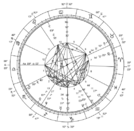Aries (astrology)
Topic: Unsolved
 From HandWiki - Reading time: 3 min
From HandWiki - Reading time: 3 min
| Aries | |
|---|---|
| Zodiac symbol | Ram |
| Duration (tropical, western) | March 20 – April 19 (2024, UT1)[1] |
| Constellation | Aries |
| Zodiac element | Fire |
| Zodiac quality | Cardinal |
| Sign ruler | Mars, Pluto |
| Detriment | Venus |
| Exaltation | Sun |
| Fall | Saturn |
| Astrology |
|---|
| Background |
| Traditions |
| Branches |
Aries (♈) /ˈɛəriːz/ (meaning "ram") is the first astrological sign in the zodiac, spanning the first 30 degrees of celestial longitude (0°≤ λ <30°). Under the tropical zodiac, the Sun transits this sign from approximately March 20 to April 21 each year.[2] This time duration is exactly the first month of Solar Hijri calendar (Hamal/Farvardin/Wray). The symbol of the ram is based on the Chrysomallus, the flying ram that provided the Golden Fleece.[3]
According to the tropical system of astrology, the Sun enters the sign of Aries when it reaches the March equinox, which time systems and the western calendar are rooted in, so as to occur on average on March 21. Because the Earth takes approximately 365.25 days to go around the Sun, the precise time of the equinox is not the same each year, and generally will occur about six hours later from one year to the next. February 29 of a leap year causes that year's vernal equinox to fall about eighteen hours earlier compared with the previous year. Since 1900 the vernal equinox date has ranged from March 20 at 08h (2000) GMT to March 21 at 19h (1903) GMT.[4] March 19 at 23:20 will occur in 2044 UT1.[1] In contrast, under the sidereal zodiac, the sun currently transits Aries from April 15 to 14 May (approximately).
Aries is the first fire sign in the zodiac, the other fire signs being Leo and Sagittarius. Individuals born between these dates, depending on which system of astrology they subscribe to, may be called Arians or Ariens.[5]
The equivalent in the Hindu solar calendar is Meṣa.[6]
Gallery
Aries, or al-ħamal, depicted in the 14th/15th century Arabic astrology text Book of Wonders.
Notes
- ↑ 1.0 1.1 Astronomical Applications Department 2011.
- ↑ Oxford n.d., s.v. Aries and Taurus.
- ↑ Atsma 2015.
- ↑ RGO c. 2015.
- ↑ Oxford n.d., s.v. Arians.
- ↑ Bangalore V. Raman (2003). Studies in Jaimini Astrology. Motilal Banarsidass. pp. 10–19. ISBN 978-81-208-1397-7. https://books.google.com/books?id=gW2DIFHrxfgC.
Works cited
- "aries". 2013. http://www.llewellyn.com/encyclopedia/term/aries.
- Astronomical Applications Department (2011), Multiyear Computer Interactive Almanac, 2.2.2., Washington DC: US Naval Observatory Longitude of Sun, apparent geocentric ecliptic of date, interpolated to find time of crossing 0°, 30°....
- Atsma, Aaron J. (2015). "Chrysomallus". The Theoi Project: Greek mythology. http://www.theoi.com/Ther/KriosKhrysomallos.html.
- "Equinoxes and solstices". Royal Museums Greenwich. c. 2015. http://www.rmg.co.uk/explore/astronomy-and-time/time-facts/equinoxes-and-solstices. Retrieved March 30, 2016.
- Oxford Dictionaries. n.d.. http://www.oxforddictionaries.com/definition/english/arian#m_en_gb0039390%20%22Arian%22. Retrieved April 21, 2018.
External links
 KSF
KSF





